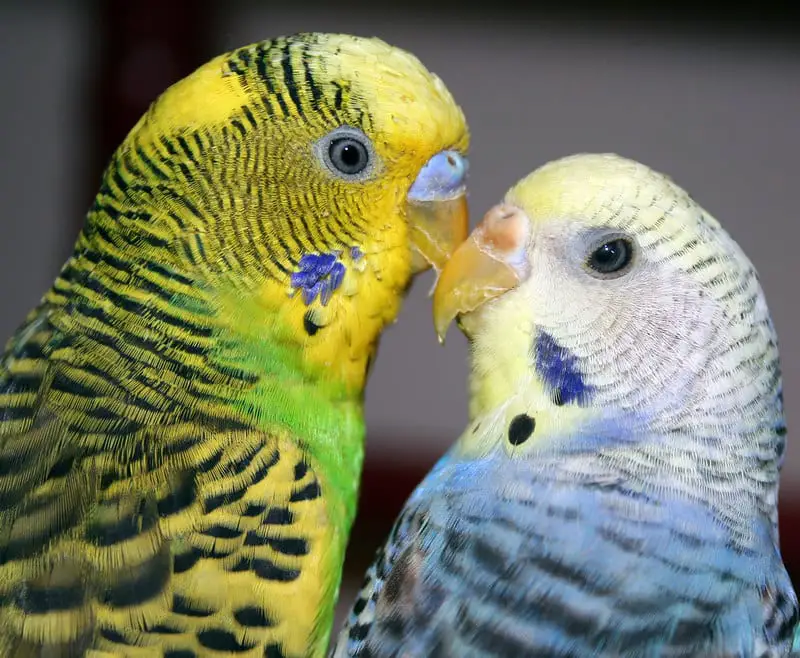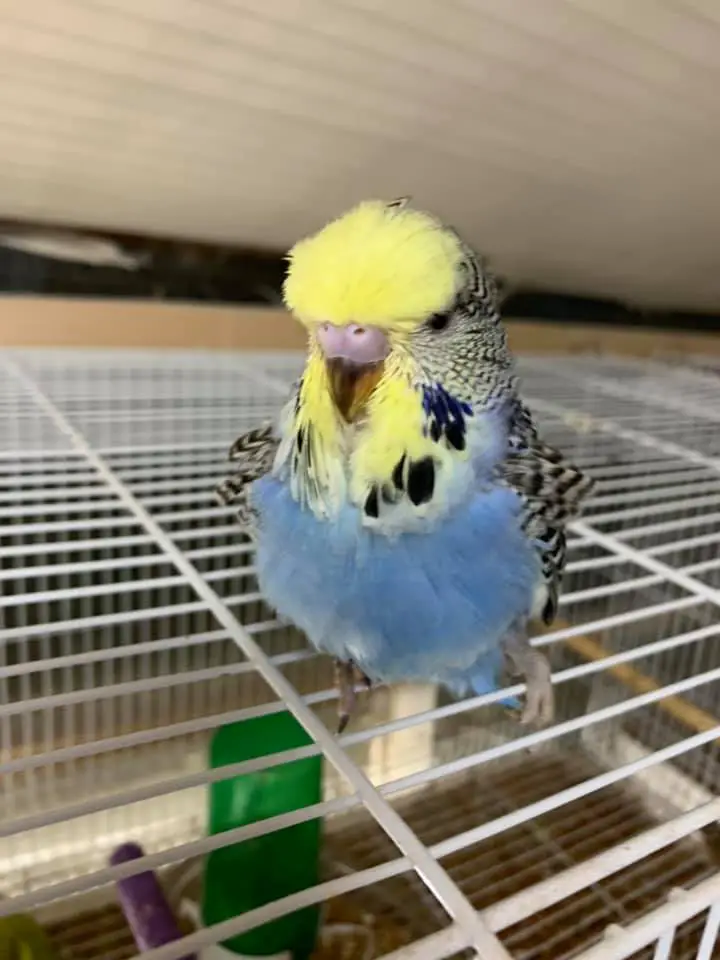How Do You Know When Your Budgie is Ready to Breed?
All babies in the animal kingdom are cute, but once a baby budgie gets its feathers, it is perhaps the most adorable, tiny, bird baby. If you are like most new budgie owners you want to know when your budgie is ready to breed, so you can have your own baby budgies.
But how do you know if your budgies are going to breed? Do you just sit and cross your fingers and wait? Do you need to provide them with special equipment? When is this going to happen?
Budgies are often but not always monogamous and pair off for life, so if you keep many budgies at home in a large cage or aviary and are looking for them to breed, the best thing is for them to pair off but we go deeper into that later on. It is possible to introduce a new budgie but we won’t go into that in this article.
To ensure things run as smoothly as possible, there are a few small things you to do to help.
| Top Recommendations For Budgie Breeding Success | Price | Prime | Buy | |
|---|---|---|---|---|
  | UnRuffledRx Bird Calcium Supplement with Magnesium +D3 - Essential for healthy budgies especially during breeding season. | PrimeEligible | Buy Now | |
  | Equa Holistics BIOFeather™ Feather Growth Dietary Supplement for Parrots. Helps maintain optimal health and disease resistance. | PrimeEligible | Buy Now | |
  | Prevue Pet Products Wooden Nest Box - The simplest and most natural commercially available Nesting Box for Budgies. | PrimeEligible | Buy Now | |
  | Jumbo Aspen Bedding - The perfect cheap solution to line your nesting boxes with. | PrimeEligible | Buy Now |
Product prices and availability are accurate as of the date/time indicated and are subject to change. Any price and availability information displayed on [relevant Amazon Site(s), as applicable] at the time of purchase will apply to the purchase of this product.
Prices pulled from the Amazon Product Advertising API on:Male and Female Budgerigars
The most obvious first step is that you need to make sure you have a male and a female bird together in the cage. When buying your budgies from a breeder, ask them to show you the differences so that you recognize what to look for in the future.
But, if you bought your birds from a pet shop and they can’t confirm the budgies’ gender, you can take them to an avian vet who can identify them for you. While you are there, let them give your budgie a health check-up to ensure they are healthy birds and then you should not encounter any problems with the breeding.
Until you know what to look for having your breeding birds looked at by a vet is a good idea. As it prevents you from breeding a hen or Cock bird that may have an inherent genetic problem.
Identifying Male and Female Budgies
It is relatively easy to tell males apart from the females, even though at a glance they look identical. Budgies have one great tell that allows you to identify males from females.
The cere (where the nostrils are, near to the beak) on male budgies is a different colour to the cere on female budges. A male budgie cere is typically a bluish colour, while in female budgies it is a white, tan, pink or brown cere.
The female’s cere will change as the bird matures. Once the hen reaches sexual maturity, at around seven months, the cere will turn to a chocolate brown colour.
There are exceptions to the rule, in some mutations such as albino and lutino or pied the male cere may be pale pinkish or light violet colour.


Image source: https://www.flickr.com/photos/35597202@N02/4217767940
When is Budgie Breeding Season
In the wild, budgies instinctively breed during the rainy spring and summer seasons, so in Northern Europe, given the right care, budgies may breed all year round.
To stimulate breeding pairs, provide your budgies with a minimum of 12 hours light per day. Natural sunlight exposure is best, if your birds are indoors making this impossible, you can use an artificial light. Light exposure is essential for the vitamin D metabolization.
Contact other budgie breeders or specialist pet stores for information on obtaining fluorescent lights for this purpose. Or you can find some fantastic deals on Amazon.
Signs Your Budgies are Going to Breed
Age plays a big part n knowing when a budgie is ready to breed.
Budgie hens can breed from six months of age, but it is not advisable to allow your hen to breed before ten months of age. Because it is as equally important that your young budgie hen is both physically and mentally mature enough to handle being a good parent.
Females can breed until they are three to four years old and males until they are five or six years.
When your budgie hen is ready to breed, her cere will become thicker and crusted over.
The male and female will start to flirt with one another, twittering at each other, touching beaks, making noises and fluttering. The male could show off his feathers and will most likely begin feeding her regurgitated food. These are excellent signs that your birds have bonded and mating is likely to occur soon.
Pregnant Budgerigar Hen
Budgies don’t get pregnant, they carry and lay eggs.
After mating, a hen budgie will lay a clutch of eggs, usually 3 but they can lay as many as 6 or more eggs. When you see the hen budgie start incubating the eggs you can start the count down. Budgie eggs will hatch after 17-23 days of incubation.
Just as a woman needs to release her eggs monthly, so a budgie need to release her eggs, even if they are not fertilized. You might even find that your female budgies lay eggs without there being a male present, this is nothing to worry about.
Physical Signs of a Pregnant Budgie “A Budgie Carrying an Egg”
Physically, it is difficult to tell if your budgie hen is ready to breed just by looking at her. Because the only difference is that when she is carrying an egg, she will put on a little bit of weight (a couple of grams).
Another sign your budgie may be ready to breed is she could start to moult and use her feathers as material for her nest.
Common Behaviour of Budgie Hens When They Are Ready to Breed
If your budgie is going to the bathroom less frequently and her droppings are larger than normal, it is a common sign that she is going to lay her egg soon,
This is because there is less room for the bird to pass droppings and as the egg moves closer to the cloacae (where the egg is expelled from), the poops get larger.
An obvious sign your budgie is ready to breed is when she starts nesting. If you have provided a nesting box, she will likely spend most of her time inside of it before laying her egg. You will also likely find her scratching and rearranging the materials inside the nesting box to be to her liking.
If there isn’t a nesting box present when your hen budgie is ready breed, she will select a section on the floor of the cage or even a food bowl and start displaying the same behaviours here. She will likely become quite territorial and protective of this space, not allowing other budgies to come near it.
As time progresses towards the actual laying of the egg, you might notice that your budgie will start to ‘pace’ or move around her cage repetitively. She could also start to compulsively clean herself, but if you are not sure then keep a watch for other potential signs of stress, especially if they have laid no eggs.
Should a Budgie Pair That is Ready to Breed be Separated from the Flock
If you have an aviary of budgies, you can leave them to get on with it and pair off naturally on their own.
After all, in the wild no-one is sitting there separating the birds off into specific pairs.
However, most breeders will select a cock and hen budgie with specific characteristics they want to see in the chicks. Which cannot be controlled in an aviary with many budgies so, it is best to remove them from the aviary and place them together in their own separate cage and allowing them time to bond.
Once they have bonded – feeding each other or ‘kissing’ one another – you can place a nest box into their cage and provide enough material to allow them to make it comfortable to start breeding.
Make sure that this cage is still within ear shot of the aviary so they can still hear the other birds chattering away.
Allow the two budgies that you have paired off a little bit of time to start interacting with one another. If your chosen pair are not compatible after two or three days, you’ll need to intervene and try your match-making skills once again.
What You Need To Know About Budgie Eggs
Once mating has been successful, your budgie will lay an egg within approximately 30 hours.
If she lays the egg on the floor of the cage and not in the nesting box you have provided, carefully move the egg (with gloved hands so you reduce the risk of removing her smell from the egg) and place it in the nesting box. She will realise that the remaining eggs should be laid here too.
After they lay the first egg, the hen budgie will continue to lay 3 – 6 eggs in a clutch within a two week period. In the wild, budgies lay 2 – 3 clutches per breeding season.
In captivity, a budgie can have 5 breeding nests in a season. This is a lot for your bird and she will become tired and this could lead to serious health complications for the hen so try not to allow this as it is not normal for a budgie hen.
The Danger of Egg Binding in Budgies and How TO avoid it Happening
Preventing Egg Binding in Budgies – If you notice your budgie has been straining for a few hours, is passing liquid droppings, has laboured breathing or you notice she is plucking the feathers around her vent, she could be suffering from egg binding, where the egg has formed inside of her but due to a variety of reasons, it will not come out.
The most common cause of egg binding in budgies, or other birds is an inadequate diet resulting in poor egg-shell development from lack of calcium, which is why I always supplement my budgies diet with a high quality calcium supplement.
Another reason for your hen suffering from egg binding is that she is too young, so her reproductive system and muscles are not yet developed enough.
Unfortunately there is little you can do to prevent your budgie coming onto the lay too early, but if you notice a young bird starting to show signs she is going to lay, make sure you keep a close eye on her.
Egg binding can also occur due to an internal physical deformity, in these cases there is not much you can do, and the hen will more often than not, sadly die trying to lay her eggs.
There are some things you can do to try and prevent your budgie from becoming egg bound in the first place though and these are:
- Make sure she has a well balanced diet including plenty of calcium.
- Give her plenty of exercise so that her muscles stay strong.
- Avoid any sudden changes in temperature or humidity.
- Make sure she has a clean and comfortable nest box to lay her eggs in.
By following these simple steps you can help to prevent your budgie hen suffering from egg binding.
I can’t stress enough that egg binding is life-threatening and should be treated as an emergency. If you notice she is struggling, get her to your avian vet immediately as she will not last more than a few hours in this state.
What Foods and Nutrients do the Budgie Hens Need when Ready to Breed?
Your budgies will continue to require the same variety of healthy food that you have been providing, however when you think your budgie is ready to breed, include added calcium in their diet to help the formation of healthy the eggs.
It is advisable to provide your budgie hen with additional calcium a few weeks prior to mating. She will also need exposure to sunlight. Sunlight and the production of Vitamin D become essential as it has an important relationship with calcium metabolism.
Pre-mating: Additional calcium + sunlight = vitamin D production and calcium absorption
If your budgies do not receive this essential vitamin D, their bodies will take calcium from their own bones which will cause their bodies to become weaker and more susceptible to broken wings and legs.
This is another reason budgies should not eat seed-only diets, but should eat a wide variety of healthy, appropriate foods.
Think about it; in the wild budgies pair off, the breed during spring or summer when there is more sunshine and they breed when food is plentiful.
You have taken these budgies in and provided them with a home, so it is your responsibility to replicate these conditions, provide sufficient healthy food and calcium and light – and provide a nesting box – and you can pretty much let nature to take its course.
How Important is having a Good Nest Bedding Material in the Nesting Box
A nest box is where the female budgie will lay her eggs and where the chicks will hatch and spend their first few weeks of life. It’s important to make sure that the nest box bedding material is of good quality, as it needs to be non-toxic and non-scented.
The size of the bedding material should also be small enough for a budgie parent to move around easily so they can create a safe environment for their young chicks. There are a few different options available on the market, but I would recommend using something like Aspen wood shavings.
These are both great options that are safe for budgies and provide a comfortable environment for them to nest in. Whatever you choose make sure that it is good at absorbing moisture, which is important in preventing mold growth.
Whichever option you choose, make sure to change out the bedding material regularly to keep it fresh and clean for your budgies. However, once your Budgie Hen starts to lay, do not disturb the bedding material.
The best free or cheap budgie nest box bedding materials
How to Check For Budgie Egg Fertility - Egg Candling
One way to check if a budgie egg is fertile is by candling it. This involves holding the egg up to a light source and looking at it closely to see if the embryo is visible.
If the embryo is present, it will appear as a dark shadow, or what may look like small dark veins against the light. Candling can be done with a handheld flashlight or a special candling lamp. Most commercial egg candling lamps are designed for Chicken eggs and are too large for budgie eggs.
I personally like the Titan Egg Candler, it is really stable and suitable to use on budgie eggs, it is pretty affordable too. What I like it you can place the egg on the supporting cup and then be free to view it from any angle without the fear of dropping your egg, yes you will do this at some point in your budgie breeding life, it is sad, but inevitable!
Another option is to use a medical light pen, the kind doctors and nurses usually carry around in their pocket to check a patients eyes and throat. These ar an an affordable easy option I like the Risemart pen, because the light tip is set in making it easy to place over the egg, many others have the light exposed, like a pencil, and this makes it harder to direct the light into the egg.
It’s best to candle the eggs in a dark room so that the light from the candling device is the only source of illumination. To candle an egg, start by gently cupping your hand around it to protect it from breakage. Then, hold the egg up to the light and look closely at it from several angles. If you see an embryo, congratulations! You’ve got a fertilized egg on your hands. If you don’t see an embryo, however, the egg is probably not fertile and won’t hatch.
Candling eggs is a quick and easy way to check their fertility status without disturbing the nesting area too much.
Conclusion
As a responsible budgie owner, you now know the signs to look out for and will know when your budgie is ready to breed. If you notice these signs, it’s important to give your budgie the right supplements to ensure a successful breeding season.
Providing a calcium supplement is the most important thing in my opinion as it will help your budgie produce strong eggs, and a vitamin E supplement will help to improve fertility and keep her feathers in good condition during the breeding season. By understanding the signs and giving the right supplements, you can help your budgie (and you) have a successful breeding season.



